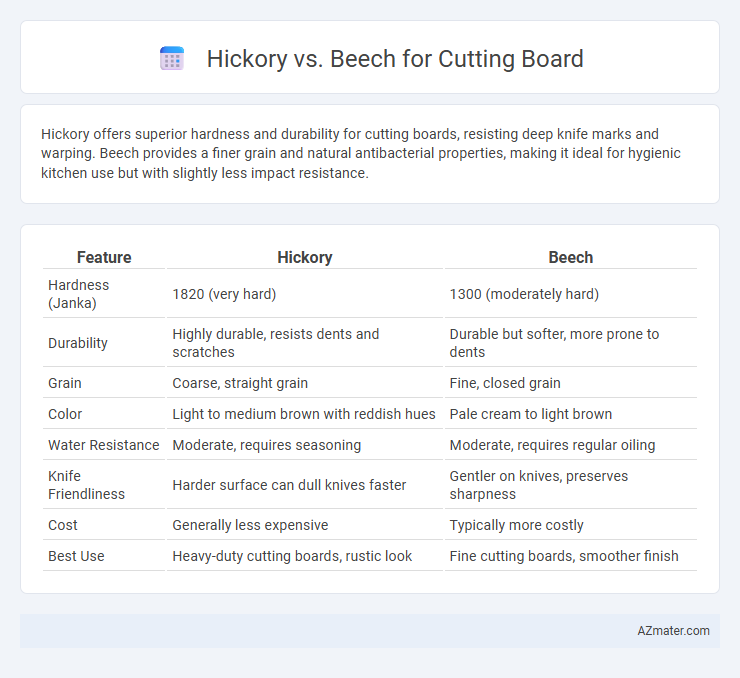Hickory offers superior hardness and durability for cutting boards, resisting deep knife marks and warping. Beech provides a finer grain and natural antibacterial properties, making it ideal for hygienic kitchen use but with slightly less impact resistance.
Table of Comparison
| Feature | Hickory | Beech |
|---|---|---|
| Hardness (Janka) | 1820 (very hard) | 1300 (moderately hard) |
| Durability | Highly durable, resists dents and scratches | Durable but softer, more prone to dents |
| Grain | Coarse, straight grain | Fine, closed grain |
| Color | Light to medium brown with reddish hues | Pale cream to light brown |
| Water Resistance | Moderate, requires seasoning | Moderate, requires regular oiling |
| Knife Friendliness | Harder surface can dull knives faster | Gentler on knives, preserves sharpness |
| Cost | Generally less expensive | Typically more costly |
| Best Use | Heavy-duty cutting boards, rustic look | Fine cutting boards, smoother finish |
Introduction to Hickory and Beech Cutting Boards
Hickory cutting boards are prized for their exceptional hardness and heavy-duty durability, making them ideal for intense chopping tasks. Beech cutting boards offer a fine, tight grain and a smoother surface, known for their resistance to knife marks and bacteria growth. Both wood types provide natural antimicrobial properties, but hickory's rugged texture contrasts with beech's elegant appearance, catering to different kitchen needs and aesthetics.
Physical Properties: Hickory vs Beech
Hickory is a dense hardwood with a Janka hardness rating of 1,820, making it highly resistant to dents and scratches, ideal for durable cutting boards. Beech has a lower Janka hardness of 1,300, offering a smoother surface but less resistance to impact compared to hickory. Both woods have fine grain structures, but hickory's superior hardness and shock resistance make it a better choice for heavy-duty use in cutting boards.
Hardness and Durability Comparison
Hickory rates around 1,820 on the Janka hardness scale, making it one of the hardest domestic woods, ideal for cutting boards requiring high resistance to dents and scratches. Beech wood measures approximately 1,300 on the Janka scale, offering moderate hardness that balances durability with a smoother surface for knife maintenance. Hickory's superior hardness ensures greater longevity and wear resistance, while beech provides a more knife-friendly cutting experience with less blade dulling.
Grain Patterns and Aesthetic Appeal
Hickory cutting boards feature a distinctive, bold grain pattern with strong contrasts between light and dark wood, offering a rustic and dramatic aesthetic. Beech cutting boards have a finer, tighter grain with a uniform, pale color that provides a smooth and elegant appearance. Both woods are durable, but the choice between Hickory and Beech primarily depends on preference for striking visual texture versus subtle, classic simplicity.
Knife-Friendliness: Which Protects Your Blades?
Beech wood is generally more knife-friendly than hickory, offering a smoother, tighter grain that reduces blade dulling and resists deep knife marks. Hickory's harder, denser structure may cause faster blade wear but provides superior durability against heavy use and impact. For cutting boards prioritizing blade protection, beech balances gentleness on knives with sufficient hardness for daily kitchen tasks.
Maintenance and Cleaning Requirements
Hickory cutting boards require regular oiling to prevent drying and cracking and can withstand frequent washing, though they should never be submerged in water for long periods. Beech cutting boards are naturally dense and less porous, making them more resistant to moisture absorption, but they still benefit from routine oiling and must be thoroughly dried after washing to avoid warping. Both woods demand hand washing with mild soap and immediate drying to maintain longevity and hygiene.
Food Safety and Porosity Considerations
Hickory and beech are popular hardwoods for cutting boards, with hickory offering superior density that limits moisture absorption, reducing bacterial penetration and enhancing food safety. Beech has a fine, closed grain structure that resists deep knife cuts, minimizing porosity and making it less prone to harboring foodborne pathogens. Both woods provide durable, sanitary surfaces, but hickory's higher hardness and low porosity make it especially suitable for preventing bacterial growth in kitchen environments.
Cost and Availability of Hickory vs Beech
Hickory cutting boards tend to be more affordable than beech due to the widespread availability of hickory in North America, reducing material costs. Beech, primarily sourced from Europe, often commands a higher price because of import expenses and limited supply. Both hardwoods are durable, but hickory's cost-effectiveness and regional abundance make it a popular choice for budget-conscious consumers.
Environmental Impact and Sustainability
Hickory cutting boards offer strong durability with moderate environmental impact, as hickory trees grow relatively fast and are commonly found in North America, allowing for sustainable harvesting practices. Beech wood is highly sustainable due to its abundant availability in Europe and North America, with a fast growth rate and efficient reforestation, resulting in a lower carbon footprint compared to many hardwoods. Both woods are biodegradable and long-lasting, but beech tends to have a lighter environmental footprint when sourced responsibly from well-managed forests.
Choosing the Best Wood for Your Cutting Board
Hickory offers exceptional hardness and durability, making it resistant to knife marks and ideal for heavy-duty cutting tasks, while beech boasts a fine, tight grain that is gentle on knives and naturally antimicrobial. Beech's moderate hardness and smooth texture promote better sanitation and less wear on cutting tools compared to hickory's more aggressive grain. Choosing between hickory and beech cutting boards depends on prioritizing durability with hickory or knife-friendliness and hygiene with beech.

Infographic: Hickory vs Beech for Cutting Board
 azmater.com
azmater.com